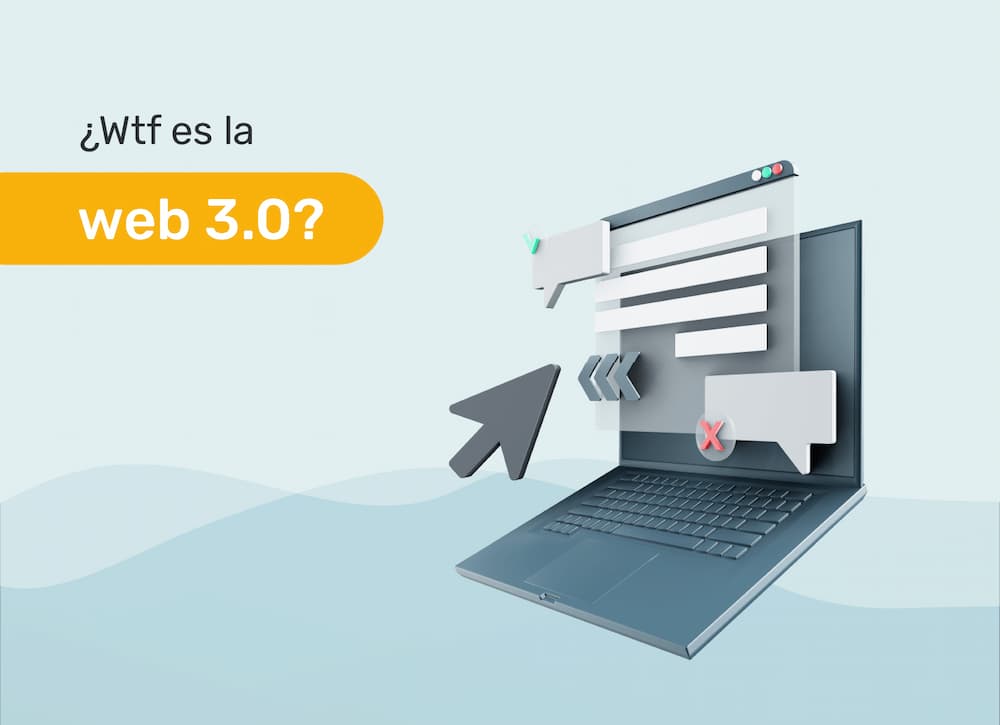Cada vez es más común escuchar de proyectos realizados en la web 3.0, en especial en el mundo de las criptomonedas. Incluso grandes ejecutivos de Google, Facebook y otras importantes compañías de tecnología están renunciando para involucrarse en startups que implican la utilización de esta web; pero ¿Qué es la web 3.0?
Si bien el concepto es muy popular en la actualidad, realmente no es un término nuevo, ya que la primera vez que se definió a la web 3.0 fue en el 2006, cuando Jeffrey Zeldman (hater de la web 2.0) publicó un artículo titulado web 3.0, el cual explicaba la necesidad de una web semántica en la que se implementaran mejoras significativas a la web 2.0.
Diferencia entre web 1.0, 2.0 y 3.0
Antes de adentrarnos en explicar que es la web 3.0 es crucial entender a sus predecesoras. La web 1.0 es la web original, aquella que surgió a finales de los 90 y solo permitía leer contenido y acceder ciertos links y páginas, los sitios básicamente carecían de interactividad, esta versión también se caracterizaba por la descentralización.
Rápidamente, se evolucionó a la web 2.0, aquella en la que la interactividad se volvió protagonista, gracias a ella surgieron las redes móviles, herramientas como JavaScript, la nube y por supuesto las redes sociales; vale acotar que en el proceso un puñado de empresas convirtieron a internet en un sitio centralizado. Básicamente, todo lo que disfrutamos hoy en día en internet proviene de la web 2.0, aunque el costo fue perder la descentralización que se promulgaba como característica inherente de internet.
Mientras la web 2.0 aún estaba despegando un hombre visionario (sí, Jeffrey Zeldman) dice que en el futuro la web va a ser más técnica, más semántica y volverá a sus orígenes en lo que a descentralización se refiere; surgiendo el término de web 3.0.
Sin embargo, debido a que aún no se había explorado ni la mitad del potencial de la web 2.0, este nuevo término acuñado por Zeldman pasó bastante desapercibido (vamos, era 2006, ni siquiera se había lanzado el primer iPhone y las redes móviles estaban en pañales). Además, no existían los protocolos necesarios para que la web evolucionara hacia su versión 3.0.
Un par de años después, surgió una tecnología esencial para el avance hacia el 3.0: ¡Blockchain! Ya que el sistema de la cadena de bloques podría permitir el regreso de la tan anhelada descentralización. Y aunque no fue de forma inmediata, con el pasar de los años la idea de evolucionar hacia la web 3.0 fue ganando popularidad.
¿Estamos presenciando el surgimiento de una nueva web?
La web 3.0 no es una nueva web en el sentido estricto de la palabra, ya que toma como base los códigos iniciales de la web 1.0 y 2.0; por lo que se puede decir que la web 3.0 es una manera de configurar la web y como interactúan y se conectan las personas a través de ella.
Incluso, hoy en día las posibilidades de la web 3.0 son mucho más amplias que las concebidas inicialmente, por el hecho de estar relacionada con criptomonedas, smart contracts, inteligencia artificial, blockchains; edge computing y por supuesto ¡Contenido descentralizado!
Hay que destacar que los términos criptomonedas y Bitcoin han sido populares y han creado sus propias culturas alrededor que observan en estas tecnologías una revolución por todo lo que nos han aportado, Sin embargo, la verdadera revolución es la que está ocurriendo en estos momentos detrás de las pantallas de aquellos que están transformando y creando infraestructuras para crear el futuro de la web.
Gracias a la web 3.0 las grandes corporaciones que dominan internet ven su poder amenazado, ya que ante la descentralización; difícilmente podrán seguir siendo dueños de todos los aspectos de tu identidad digital. Esto se debe a que a través de la web 3.0 se crean wallets y plataformas que permiten que seas el dueño de todos tus datos e identidad digital, lo cual pinta un futuro bastante interesante ¿No lo crees?
Ejemplos de web 3.0
Todo se entiende mejor a través de la ejemplificación. Un ejemplo que vale la pena mencionar es el navegador Brave, el cual a través de la descentralización permite que los usuarios obtengan recompensas por una actividad que se suele realizar de forma gratuita; la navegación web.
Es cierto que este navegador aún no es tan popular como Google (aunque ya acumula 50 millones de usuarios), e incluso ha tenido ciertas críticas, nos hace preguntarnos ¿Qué ocurriría si los navegadores más populares decidieran optar por un modelo similar en el que se conectaran a una wallet y a través de esta se pudiese conectar con otros proyectos y ganar recompensas?
Estos conceptos son difíciles de asimilar, incluso para los apasionados del mundo cripto, ya que aún falta usabilidad e interfaces más accesibles para los desarrolladores. De hecho, las existentes son diseñadas para developers expertos, creando una gran brecha para masificar proyectos de la web 3.0, esto también dificulta que se creen interfaces móviles basadas en web 3.0.
Es por eso que proyectos como Celo y El Dorado destacan entre la comunidad entusiasta de la web 3.0, ya que su principal enfoque ha sido el desarrollo nativo desde interfaces móviles, permitiendo una mayor usabilidad de una de las funciones más asombrosas de la red 3.0; la descentralización financiera.
Gracias a la web 3.0, puedes encontrar en El Dorado un aliado para manejar tus finanzas de forma más descentralizada, al intercambiar tu moneda local por dólares, euros y Bitcoins. ¿Te gustaría disfrutar uno de los principales beneficios de la web 3.0 a través de El Dorado? ¡Puedes ser parte de esta plataforma aquí!





